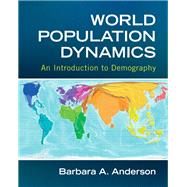Examines Demographic Trends from an Historical and Comparative Perspective.
World Population Dynamics: An Introduction to Demography, 1/e by Barbara A. Anderson takes an historical and comparative approach that places demographic conditions and changes in context and illuminates their importance in the past, and present and in years to come. With sociological, economic, health, and political perspectives integrated throughout, readers will gain an understanding of the patterns and causes of population change historically and in the contemporary world.








